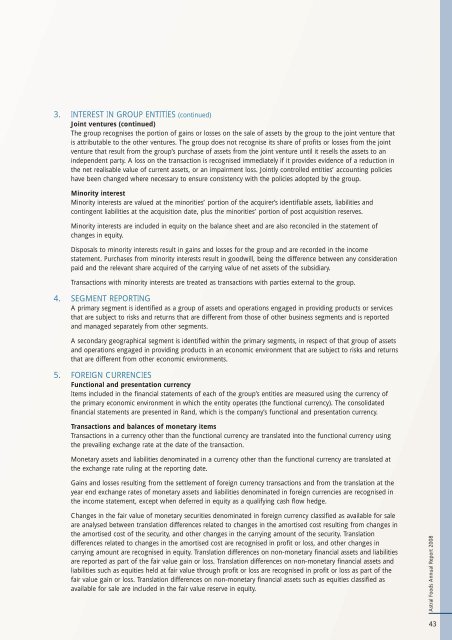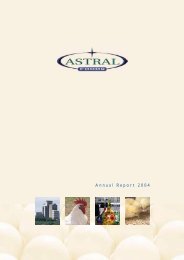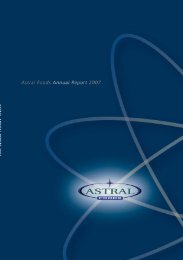Astral Foods Annual Report 2008
Astral Foods Annual Report 2008
Astral Foods Annual Report 2008
Create successful ePaper yourself
Turn your PDF publications into a flip-book with our unique Google optimized e-Paper software.
3. INTEREST IN GROUP ENTITIES (continued)Joint ventures (continued)The group recognises the portion of gains or losses on the sale of assets by the group to the joint venture thatis attributable to the other ventures. The group does not recognise its share of profits or losses from the jointventure that result from the group’s purchase of assets from the joint venture until it resells the assets to anindependent party. A loss on the transaction is recognised immediately if it provides evidence of a reduction inthe net realisable value of current assets, or an impairment loss. Jointly controlled entities’ accounting policieshave been changed where necessary to ensure consistency with the policies adopted by the group.Minority interestMinority interests are valued at the minorities’ portion of the acquirer’s identifiable assets, liabilities andcontingent liabilities at the acquisition date, plus the minorities’ portion of post acquisition reserves.Minority interests are included in equity on the balance sheet and are also reconciled in the statement ofchanges in equity.Disposals to minority interests result in gains and losses for the group and are recorded in the incomestatement. Purchases from minority interests result in goodwill, being the difference between any considerationpaid and the relevant share acquired of the carrying value of net assets of the subsidiary.Transactions with minority interests are treated as transactions with parties external to the group.4. SEGMENT REPORTINGA primary segment is identified as a group of assets and operations engaged in providing products or servicesthat are subject to risks and returns that are different from those of other business segments and is reportedand managed separately from other segments.A secondary geographical segment is identified within the primary segments, in respect of that group of assetsand operations engaged in providing products in an economic environment that are subject to risks and returnsthat are different from other economic environments.5. FOREIGN CURRENCIESFunctional and presentation currencyItems included in the financial statements of each of the group’s entities are measured using the currency ofthe primary economic environment in which the entity operates (the functional currency). The consolidatedfinancial statements are presented in Rand, which is the company’s functional and presentation currency.Transactions and balances of monetary itemsTransactions in a currency other than the functional currency are translated into the functional currency usingthe prevailing exchange rate at the date of the transaction.Monetary assets and liabilities denominated in a currency other than the functional currency are translated atthe exchange rate ruling at the reporting date.Gains and losses resulting from the settlement of foreign currency transactions and from the translation at theyear end exchange rates of monetary assets and liabilities denominated in foreign currencies are recognised inthe income statement, except when deferred in equity as a qualifying cash flow hedge.Changes in the fair value of monetary securities denominated in foreign currency classified as available for saleare analysed between translation differences related to changes in the amortised cost resulting from changes inthe amortised cost of the security, and other changes in the carrying amount of the security. Translationdifferences related to changes in the amortised cost are recognised in profit or loss, and other changes incarrying amount are recognised in equity. Translation differences on non-monetary financial assets and liabilitiesare reported as part of the fair value gain or loss. Translation differences on non-monetary financial assets andliabilities such as equities held at fair value through profit or loss are recognised in profit or loss as part of thefair value gain or loss. Translation differences on non-monetary financial assets such as equities classified asavailable for sale are included in the fair value reserve in equity.<strong>Astral</strong> <strong>Foods</strong> <strong>Annual</strong> <strong>Report</strong> <strong>2008</strong>43






